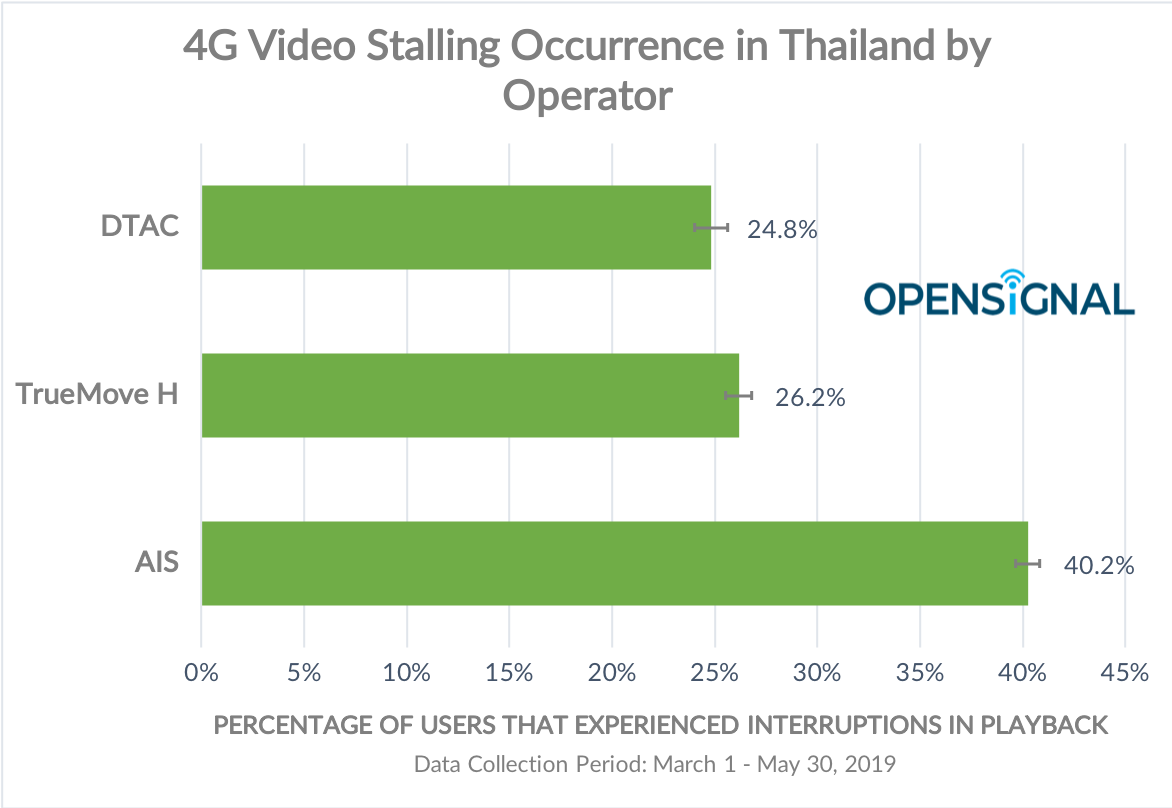In our recent Mobile Network Experience report on Thailand, we found that Thai operators excelled in 4G Availability, providing a level of 4G access nearly unmatched in Southeast Asia, but we also identified one area where Thailand needed a lot of improvement. That area was Video Experience. No operator in Thailand earned better than a Fair score in our Video Experience ratings — even when we looked at 4G connection speeds alone — attesting to long wait times for videos to load and frequent pauses in video playback. Opensignal has taken a closer look at Video Experience in Thailand to see why it rates low in our measurements and what could be done to improve those scores.
 For this analysis, we examined two key components of our Video Experience metric: 4G Video Load Time and 4G Video Stalling Occurrence. The first metric, Video Load Time, measures the average amount of time in seconds a consumer waits for a video to load and begin streaming. As you can see, our Thai users did experience quite a bit of downtime before video began playing.
For this analysis, we examined two key components of our Video Experience metric: 4G Video Load Time and 4G Video Stalling Occurrence. The first metric, Video Load Time, measures the average amount of time in seconds a consumer waits for a video to load and begin streaming. As you can see, our Thai users did experience quite a bit of downtime before video began playing.
Some lag time is to be expected on any video streamed via a mobile network. Even our users in Singapore, which scored the highest in Southeast Asia in Video Experience, are accustomed to waiting 2-3 seconds to enjoy their video streams. In that light, TrueMove H's Video Load Time score of 4.9 seconds and DTAC's score of 5.7 seconds — while hardly ideal — aren't outlandish. Our AIS users, however, had to wait an average of more than 7 seconds for the first video frame to render.
When we look at Video Stalling Occurrence, though, we really begin to see the limitations in the Thai mobile video experience. Video Stalling Occurrence measures the proportion of users who suffer an interruption during playback, whether it’s a stutter in the video stream, a longer pause for buffering or the video timing out completely. In countries where 4G Video Experience is Good or Excellent, we expect to see Video Stalling Occurrence well under 10%. To keep with our earlier example, all three of Singapore's operators had scores in this metric below 5%.
 Not a single Thai operator, however, had a Video Stalling Occurence score below 20%. DTAC and TrueMove ranked highest, with about a quarter of our users on their networks experiencing video interruptions. AIS, though, had a Video Stalling Occurrence score of just over 40%, meaning stops in playback were quite common. It's no coincidence that AIS was the only Thai operator to garner our lowest Video Experience rating, Poor, in our report on Thailand.
Not a single Thai operator, however, had a Video Stalling Occurence score below 20%. DTAC and TrueMove ranked highest, with about a quarter of our users on their networks experiencing video interruptions. AIS, though, had a Video Stalling Occurrence score of just over 40%, meaning stops in playback were quite common. It's no coincidence that AIS was the only Thai operator to garner our lowest Video Experience rating, Poor, in our report on Thailand.
So what can Thai operators do to improve the Video Experience their customers receive? Operators could add more capacity to their networks by tapping new sources of spectrum, building more cell sites, or linking more powerful backhaul connections to existing cell sites. Operators could also implement content management technologies that would optimize video traffic. Boosting average download speeds is another solution. Faster speeds don't always guarantee a better Video Experience, but there does seem to be a minimum level of speed operators need to maintain in order to move the needle on video quality. In our State of Mobile Video report, published in September, nearly every single country with a Poor or Fair rating had average overall download speeds below 14 Mbps. Thailand definitely fell into that category. No operator in the country had a Download Speed Experience score above 8 Mbps in our Thai report.
Thailand's low speeds may very well be by design. Thailand's operators have been more successful at expanding 4G Availability than at increasing the raw speeds they deliver to consumers. Some Thai operators even restrict the speeds available to consumers on different plans to offer more affordable 4G pricing options. As long as the 4G balance in Thailand remains tilted toward access rather than speed, we'll likely see Video Experience scores stay low. But we are starting to see signs that balance is shifting.
We've recorded some sizable increases in DTAC's average download speeds over the last year as it has invested in new 4G spectrum and infrastructure. If that spurs its competitors to follow suit, then we may see not only Download Speed Experience scores rising, but also greater consistency in connections and boosted network capacity. And those in turn will almost certainly lead to an improved Video Experience.
Opensignal Limited retains ownership of this insight including all intellectual property rights, data, content, graphs & analysis. Reports and insights produced by Opensignal Limited may not be quoted, reproduced, distributed, published for any commercial purpose (including use in advertisements or other promotional content) without prior written consent. Journalists are encouraged to quote information included in Opensignal reports and insights provided they include clear source attribution. For more information, contact [email protected].
